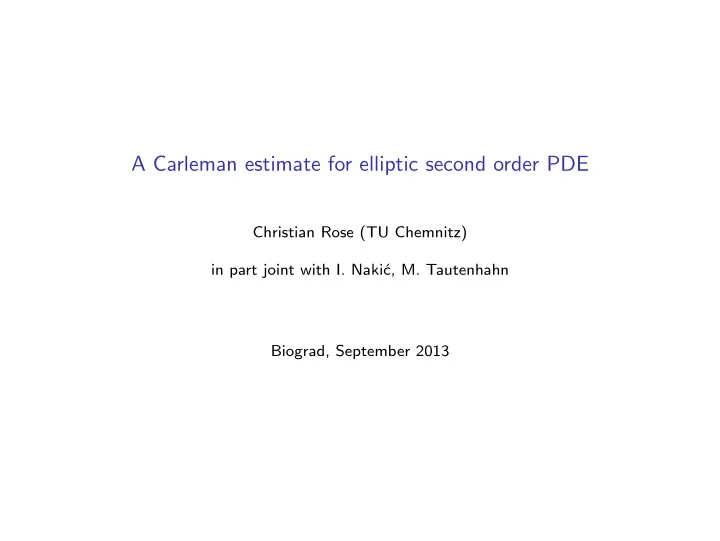

A Carleman estimate for elliptic second order PDE Christian Rose (TU Chemnitz) in part joint with I. Naki´ c, M. Tautenhahn Biograd, September 2013
Theorem [Bourgain, Kenig 05] There exist C ( d ) , D ( d ) , E ( d ) > 0 and a function w : R d → R such that for all f ∈ C ∞ c ( B 1 (0) \ { 0 } ) and all α > D � � w − 1 − 2 α f 2 ≤ E α 3 w 2 − 2 α (∆ f ) 2 . weight function φ : R + → R + , �� ∞ e − t − 1 � φ ( r ) = r exp , dt t 0 w : R d → R , w ( x ) = φ ( | x | ) .
Application: Scale-free unique continuation principle Theorem [Rojas-Molina & Ves. 13] Let δ, K > 0. Then ∃ C ∈ (0 , ∞ ), s.t. ∀ ◮ V : R d → [ − K , K ], L ∈ N ◮ ψ ∈ W 2 , 2 (Λ L ; R ), H L ψ = 0 ◮ ( x j ) j ∈ Z d ⊂ R d , B ( x j , δ ) ⊂ Λ 1 + j � � ψ 2 ≥ C ◮ Λ L = ( − L / 2 , L / 2) d ψ 2 = ⇒ S L Λ L � � ◮ S L = Λ L ∩ � B ( x j , δ ) j ∈ Z d ◮ H L = ( − ∆ + V ) Λ L with Dirichlet or periodic b.c. at ∂ Λ L
Generalisation to elliptic second order partial differential operators Assumptions L second order partial differential operator L = � d i , j =1 ∂ i ( a ij ∂ j ) satisfies ◮ symmetric coefficients, a ij = a ji ∀ i , j ∈ { 1 , . . . , d } , ◮ ellipticity, ∃ ξ : ∀ x ∈ B 1 (0): 1 /ξ | x | 2 ≤ � d i , j =1 a ij ( x ) x i x j ≤ ξ | x | 2 , ◮ Lipschitz continuity, ∃ θ : ∀ x , y ∈ B 1 (0): � d i , j =1 | a i , j ( x ) − a i , j ( y ) | ≤ θ | x − y | . Theorem [ongoing work] There exist C , D , E > 0 and a function w : R d → R depending on Lipschitz and ellipticity constants, such that for all f ∈ C c ( B 1 (0) \ { 0 } ) and all α > D � � α w 1 − 2 α |∇ f | 2 + α 3 w − 1 − 2 α f 2 ≤ E w 2 − 2 α ( Lf ) 2 . ◮ Similar weight function, depends on constant µ adapted to the operator. ◮ Open question: How does µ scale with Lipschitz constant? Conjecture is linear.
Recommend
More recommend